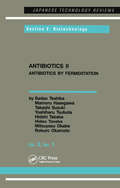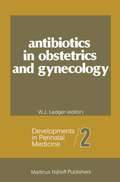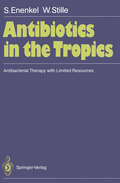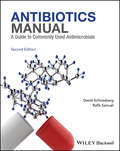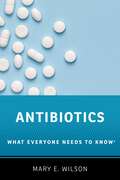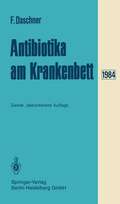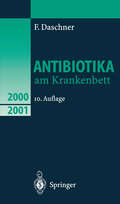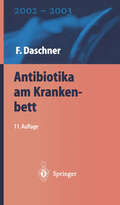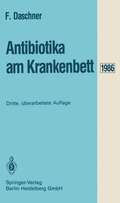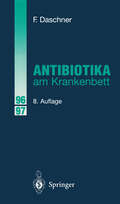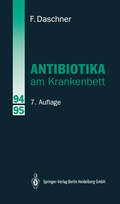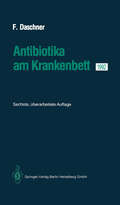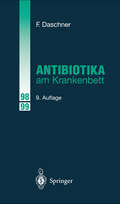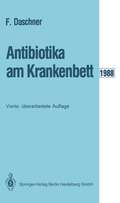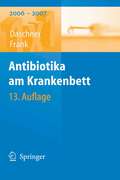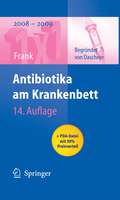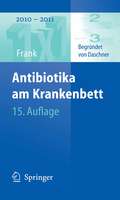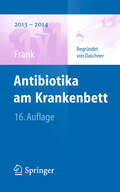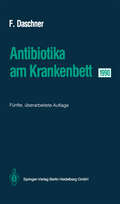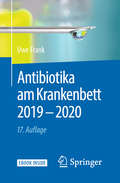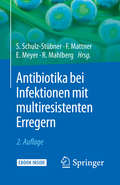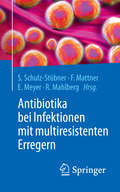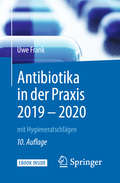- Table View
- List View
Antibiotics II
by Sadao TeshibaThis book reviews more recent studies of antibiotics in Japan. It covers astromicin, application of cyclodextrin in the fermentative production process, production of Bialaphos from a Biochemical Engineering viewpoint, and acyl derivatives of tylosin produced by microbial transformation.
Antibiotics II
by Sadao TeshibaThis book reviews more recent studies of antibiotics in Japan. It covers astromicin, application of cyclodextrin in the fermentative production process, production of Bialaphos from a Biochemical Engineering viewpoint, and acyl derivatives of tylosin produced by microbial transformation.
Antibiotics in Obstetrics and Gynecology (Developments in Perinatal Medicine #2)
by William J. LedgerThe motive to prepare this volume on antibiotics for the physician caring for women was based upon the editor's perception that the subject matter had never been fully developed for the obstetrician-gynecologist. Most textbooks of infectious disease have a small section devoted to antibiotics, which has little relevance for the physician caring for post-operative or post-partum infections. Basic antibiotic pharmacology is described and there is a reflex prohibition of antibiotics for the pregnant woman. Correctly, the reader assumes that the authors themselves do not care for women with bacterial infections of the pelvis. Recent texts in infectious disease in obstetrics gynecology have been little better. Although the focus has been more clini cally oriented, space requirements have too often kept the discussions at a superficial level. A total focus upon antibiotics in this volume eliminates the restraints of space in prior publications. The greatest reward in my task as editor of this volume is related to the quality of the individual authors. They range from former students, to con temporary colleagues, to respected peers in infectious disease. Since the quality of this volume is related to the sum total of the individual chapters, I wish to comment about each of the contributors. Philip Mead from the University of Vermont is an old friend, who brings to the question of prophylactic antibiotics, his wide clinical experience and encyclopedic knowledge.
Antibiotics in the Tropics: Antibacterial Therapy with Limited Resources
by Sabine Enenkel Wolfgang StilleInternational textbooks on infectious diseases and antibacterial chemotherapy are usually written for readers in North America and Europe. In many ways, they are not appropriate for the prob lems encountered in developing countries. This book, in contrast, intends to define the rules of antibacterial chemotherapy practised under conditions of limited resources. It is meant for everyone con cerned with the use of antibiotics in developing countries, includ ing doctors, medical assistants, pharmacists, officials in health mio isteries, and medical students. Throughout the book, treatment recommendations are made for 1 antibiotics from the WHO list of essential drugs. For example, em phasis has therefore been put upon chloramphenicol as a stable, unexpensive and widely available oral agent suitable for the treat ment of severe bacterial infections like septicemia and meningitis. So-called "international chemotherapy" with modem cephalospor ins and acylaminopenicillins has been outlined for comparison. Since it is the aim of the book to base treatment recommenda tions on data from developing countries, many data on the etiology of common bacterial infections in developing countries have also been included. Most of the data are from African, English-speak ing developing countries, but references have been made to the lit erature on South East Asia, India or Papua New Guinea, where appropriate. On the other hand, pertinent data were not available in every instance, so that several statements and recommendations had to be made as "best guess". The authors are aware of these imperfections and will welcome comments from the readers.
Antibiotics Manual: A Guide to commonly used antimicrobials
by David L. Schlossberg Rafik SamuelA comprehensive compendium of all commonly used antibiotics, including indications, side effects, dosage information, and drug/food interactions Antibiotics Manual: A Guide to Commonly Used Antimicrobials, Second Edition is a unique, user-friendly guide made for all who prescribe antibiotics. It’s the only book available that takes a 100% drug-listed approach to 200 of the most common antibiotics prescribed to patients each day. Presented in full color, it’s also a convenient reference for every clinician to consult once the decision to use a particular antibiotic has been reached. This edition of Antibiotics Manual includes newer antibiotics that have been released since the publication of the First Edition and updates prescribing information for the older antibiotics. This all-new Second Edition: Has a color-coded interior design which provides quick and easy point of care access for the user Includes 200 of the most commonly prescribed antibiotics, listed by both brand and generic names Features important recently-released antibiotics such as ceftaroline, tedizolid, and bedaquiline Antibiotics Manual: A Guide to Commonly Used Antimicrobials, Second Edition is a welcome book for physicians in all specialties of medicine who prescribe antibiotics. It is also a handy tool for pharmacists, nurses, nurse practitioners, and physician assistants who want more information on the drugs they administer.
Antibiotics Manual: A Guide to commonly used antimicrobials
by David L. Schlossberg Rafik SamuelA comprehensive compendium of all commonly used antibiotics, including indications, side effects, dosage information, and drug/food interactions Antibiotics Manual: A Guide to Commonly Used Antimicrobials, Second Edition is a unique, user-friendly guide made for all who prescribe antibiotics. It’s the only book available that takes a 100% drug-listed approach to 200 of the most common antibiotics prescribed to patients each day. Presented in full color, it’s also a convenient reference for every clinician to consult once the decision to use a particular antibiotic has been reached. This edition of Antibiotics Manual includes newer antibiotics that have been released since the publication of the First Edition and updates prescribing information for the older antibiotics. This all-new Second Edition: Has a color-coded interior design which provides quick and easy point of care access for the user Includes 200 of the most commonly prescribed antibiotics, listed by both brand and generic names Features important recently-released antibiotics such as ceftaroline, tedizolid, and bedaquiline Antibiotics Manual: A Guide to Commonly Used Antimicrobials, Second Edition is a welcome book for physicians in all specialties of medicine who prescribe antibiotics. It is also a handy tool for pharmacists, nurses, nurse practitioners, and physician assistants who want more information on the drugs they administer.
ANTIBIOTICS WENK C: What Everyone Needs to Know® (What Everyone Needs To Know®)
by Mary E. WilsonVirtually everyone has taken antibiotics. They can be lifesavers -- and they can be useless. What are they? How are they used? And what happens as the effectiveness of antibiotics continues to decline? Antibiotics: What Everyone Needs to Know® examines the personal and societal implications of our planet's most important -- and frequently misused -- medications. In a question-and-answer format, it unpacks the most complicated aspects of this issue, including: How antibiotics are used (and overused) in humans, plants, and livestock; the causes and consequences of bacterial resistance to antibiotics; how the globalized world enables antibiotic resistance to spread quickly; and the difficult decisions ahead for both medical care and the food system. Grounded in the latest scientific research and crafted for general readers, Antibiotics: What Everyone Needs to Know® offers a clear-eyed overview of where we are, and what the future holds, as antibiotics lose their power.
Antibiotika am Krankenbett
by F. DaschnerEs paßt in jede Kitteltasche und ist ein "Spicker" für alle praktisch tätigen Ärzte in Klinik und Praxis. Bei der fast unübersehbaren Zahl an Antibiotika ist eine aktuelle, übersichtliche Darstellung unerläßlich. In überschaubaren Tabellen - nach Substanzen, Erregern und Indikationen geordnet - können Keimspektrum und Dosierungsempfehlungen rasch nachgeschlagen werden. Auch spezielle Probleme, wie z.B. Antibiotika in der Schwangerschaft oder präoperative Infektionsprophylaxe werden in Daschners zehnter Auflage von Antibiotika am Krankenbett berücksichtigt. Ein Ratgeber für die tägliche Arbeit in der Klinik.
Antibiotika am Krankenbett
by F. DaschnerEs passt in jede Kitteltasche und ist ein "Spicker" für alle praktisch tätigen Ärzte in Klinik und Praxis. Bei der fast unübersehbaren Zahl an Antibiotika ist eine aktuelle, übersichtliche Darstellung unerläßlich. In überschaubaren Tabellen - nach Substanzen, Erregern und Indikationen geordnet - können Keimspektrum und Dosierungsempfehlungen rasch nachgeschlagen werden. Auch spezielle Probleme, wie z.B. Antibiotika in der Schwangerschaft oder präoperative Infektionsprophylaxe werden in Daschners elfter Auflage von Antibiotika am Krankenbett berücksichtigt. Ein Ratgeber für die tägliche Arbeit in der Klinik.
Antibiotika am Krankenbett
by Franz DaschnerEs paßt in jede Kitteltasche und ist ein "Spicker" für alle Ärzte in Klinik und Praxis. Das handliche Taachenbuch macht die Antibiotikafülle überschaubar und liefert alle praktisch relevanten Daten - vom Keimspektrum über Indikationen und Dosierungsempfehlungen bis hin zu speziellen Fragestellungen - übersichtlich und auf dem aktuellen Stand.
Antibiotika am Krankenbett
by Franz DaschnerDie 7. Auflage bietet den Ärzten in Klinik und Praxis eine rasche Orientierung über die Indikationsbreite der auf dem Markt existierenden Antibiotika, Antimykotika und Tuberkulostatika.
Antibiotika am Krankenbett
by Franz DaschnerDie 6. Auflage des Taschenbuches bietet dem Arzt in Klinik und Praxis eine rasche Orientierung }ber die Indikationsbreite der auf dem Markt existierenden Antibiotika, Antimykotika und Tuberkulostatika.
Antibiotika am Krankenbett
by Franz DaschnerEs paßt in jede Kitteltasche und ist ein "Spicker" für alle praktisch tätigen Ärzte in Klinik und Praxis. Bei der fast unübersehbaren Zahl an Antibiotika ist eine aktuelle, übersichtliche Darstellung unerläßlich. In überschaubaren Tabellen - nach Substanzen, Erregern und Indikationen geordnet - können Keimspektrum und Dosierungsempfehlungen rasch nachgeschlagen werden. Auch spezielle Probleme, wie z. B. Antibiotika in der Schwangerschaft oder präoperative Infektionsprophylaxe werden in Daschners neunter Auflage von Antibiotika am Krankenbettt berücksichtigt. Ein Ratgeber für die tägliche Arbeit in der Klinik.
Antibiotika am Krankenbett
by Franz DaschnerAuch die 4., überarbeitete Auflage dieses Taschenbuches bietet dem Arzt in Klinik und Praxis eine rasche Orientierung über die Indikationsbreite der auf dem Markt existierenden Antibiotika. In straffer und übersichtlicher Gliederung unter weitgehender Benutzung von tabellarischen Übersichten und Stichwortkatalogen werden alle Fragen behandelt, die die praktische Anwendung von Antibiotika, Antimykotika und Tuberkulostatika aufwirft. Alle aktuellen Aspekte wie z.B. unterschiedliche Therapiedosierung bei Erwachsenen, Kindern und Säuglingen, Antibiotikadosierung in der Schwangerschaft, Therapie bei eingeschränkter Nierenfunktion, Nebenwirkung und Wechselwirkungen mit anderen Pharmaka werden ohne ausführliche Darstellung theoretischer Grundlagen kurz und präzise aufgelistet. Aus den Besprechungen: "Die Fülle und Dichte der Informationen ist sehr geschickt und übersichtlich gegliedert, so daß durch sie eine rasche Orientierung und Übersicht nicht behindert wird... Abschließend sei noch auf die Auflistung der Generics und der Handelsnamen sowie auf das umfassende und vorzügliche Sachwortverzeichnis hingewiesen, die die praktische Nutzbarkeit des Büchleins entscheidend mitbestimmen." Zentralorgan Chirurgie#1 "...daß jeder therapeutisch tätige Arzt das Büchlein immer greifbar haben sollte, weil er alle mit der Anwendung von Antibiotica und Chemotherapeutica verbundenen Fragen schnell beantwortet bekommt." Zentralblatt Praktische Innere Medizin#2
Antibiotika am Krankenbett (1x1 der Therapie)
by Franz Daschner Uwe FrankEr passt in jede Kitteltasche und ist ein "Spicker" für alle praktisch tätigen Ärzte in Klinik und Praxis. Bei der fast unübersehbaren Anzahl an Antibiotika ist eine aktuelle, übersichtliche Darstellung unerlässlich. In überschaubaren Tabellen - nach Substanzen, Erregern und Indikationen geordnet - können Keimspektrum und Dosierungsempfehlungen rasch nachgeschlagen werden. Inklusive spezieller Probleme wie Antibiotika in der Schwangerschaft, präoperative Infektionsprophylaxe oder Nieren- und Leberinsuffizienz. Ein Ratgeber für die tägliche Arbeit in der Klinik: griffbereit, prägnant und übersichtlich.
Antibiotika am Krankenbett (1x1 der Therapie)
by Uwe FrankEr passt in jede Kitteltasche und ist ein "Spicker" für alle praktisch tätigen Ärzte in Klinik und Praxis. Bei der fast unübersehbaren Anzahl an Antibiotika ist eine aktuelle, übersichtliche Darstellung unerlässlich. In überschaubaren Tabellen - nach Substanzen, Erregern und Indikationen geordnet - können Keimspektrum und Dosierungsempfehlungen rasch nachgeschlagen werden. Inklusive spezieller Probleme wie Antibiotika in der Schwangerschaft, präoperative Infektionsprophylaxe oder Nieren- und Leberinsuffizienz. Ein Ratgeber für die tägliche Arbeit in der Klinik: griffbereit, prägnant und übersichtlich.
Antibiotika am Krankenbett (1x1 der Therapie)
by Uwe FrankAngesichts einer fast unüberschaubaren Anzahl an Antibiotika bietet der Klinik-Ratgeber schnelle Orientierung: In den übersichtlichen, nach Substanzen, Erregern und Indikationen geordneten Tabellen können Keimspektrum und Dosierungsempfehlungen rasch nachgeschlagen werden. Auch spezielle Probleme wie Antibiotika in der Schwangerschaft, präoperative Infektionsprophylaxe oder Nieren- und Leberinsuffizienz werden behandelt. Die 15. Auflage berücksichtigt neueste Antibiotika/Antimykotika, Indikationen sowie aktuelle Resistenzen.
Antibiotika am Krankenbett (1x1 der Therapie)
by Uwe FrankMit einer Vielzahl von Antibiotika-Wirkstoffen und immer neuen Antibiotika-Resistenzen ist das Gebiet der Antibiotika-Therapie kaum zu übersehen. Der Band bietet daher einen Überblick in überschaubaren Tabellen, geordnet nach Substanzen, Erregern und Indikationen. Keimspektrum und Dosierungsempfehlungen können so rasch nachgeschlagen werden. Darüber hinaus werden spezielle Probleme wie Antibiotika in der Schwangerschaft, präoperative Infektionsprophylaxe oder Nieren- und Leberinsuffizienz behandelt.
Antibiotika am Krankenbett 2019 - 2020 (1x1 der Therapie)
by Uwe FrankGriffbereit - prägnant – übersichtlich Der Kitteltaschen-Ratgeber für die Klinik zur Therapie von Infektionskrankheiten Die wichtigsten Antibiotika und Antimykotika: Spektrum - Dosierung - Nebenwirkungen Zahlreiche Tabellen geordnet nach Substanzen, Erregern und Indikationen Antibiotikagabe bei Schwangerschaft, Nieren- und Leberinsuffizienz, Dialyse Zahlreiche Tipps und Problemlösungen u.a. zu Potentiellen Behandlungsfehlern Therapieversagen Perioperativer Antibiotikaprophylaxe
Antibiotika bei Infektionen mit multiresistenten Erregern
by Sebastian Schulz-Stübner Frauke Mattner Elisabeth Meyer Rolf MahlbergDieses Kitteltaschenbuch vermittelt prägnant und anhand vieler Praxistipps die wichtigsten Fakten für die erfolgreiche Therapie von Infektionen mit multiresistenten Erregern wie MRSA, VRE, MRGN und MDR-TB. Lesen Sie, welche Antibiotika bei welchen Infektionen greifen und wie sich Therapieversagen und Resistenzentwicklungen verhindern lassen. Das Werk wendet sich an alle Ärzte, die Patienten mit Infektionen durch multiresistente Erreger betreuen. Die 2. Auflage erscheint komplett aktualisiert und erweitert.Der InhaltDie wichtigsten Antibiotika bei Infektionen durchmultiresistente Staphylococcus aureus (MRSA), wie eitrige Weichteil- und Gewebsinfektionen, Bakteriämien, Endokarditiden, Osteomyelitis, septische Arthritis und ZNS-Infektionenmultiresistente gramnegative Erregern (MRGN)Vancomycin resistente Enterokokken (VRE) „multidrug resistent tuberculosis“ (MDR-TB), wie der MDR/XDR-TBC oder XDR-TBBesonderes Praxis-Plus: eBook inside - kostenloser Download des eBooks inklusive
Antibiotika bei Infektionen mit multiresistenten Erregern
by Sebastian Schulz-Stübner Frauke Mattner Elisabeth Meyer Rolf MahlbergDieses Kitteltaschenbuch vermittelt prägnant und übersichtlich die wichtigsten Fakten für die erfolgreiche Therapie von Infektionen mit multiresistenten Erregern wie MRSA, VRE, MRGN und MDR-TB. Lesen Sie, welche Antibiotika bei welchen Infektionen greifen und wie sich Therapieversagen und Resistenzentwicklungen verhindern lassen. Das Werk wendet sich an alle Ärzte, die Patienten mit Infektionen durch multiresistente Erreger betreuen.Der InhaltDie wichtigsten Antibiotika bei Infektionen durchmultiresistente Staphylococcus aureus (MRSA), wie eitrige Weichteil- und Gewebsinfektionen, Bakteriämien, Endokarditiden, Osteomyelitis, septische Arthritis und ZNS-Infektionenmultiresistente gramnegative Erregern (MRGN)Vancomycin resistente Enterokokken (VRE) „multidrug resistent tuberculosis“ (MDR-TB), wie der MDR/XDR-TBC oder XDR-TBPlus: Checkliste für das beste Vorgehen im Verdachtsfall und viele Praxistipps
Antibiotika in der Praxis 2019 - 2020: mit Hygieneratschlägen (1x1 der Therapie)
by Uwe FrankDas Gebiet der Antibiotika-Therapie ist durch eine Vielzahl von Substanzen und die Entwicklung neuer Resistenzen nicht leicht zu überblicken. Der Band liefert deshalb in prägnanter Form das aktuelle Wissen zu wichtigen Antibiotika-Resistenzen, zu neuesten Präparaten, ihrem Wirkspektrum und ihrer Anwendung. Die Antibiotika-Therapie aller wichtigen Infektionen wird in Tabellen kurz und übersichtlich dargestellt. Der Band enthält Hygieneratschläge und wurde für die Neuauflage um ein Kapitel über die pflanzliche antiinfektiöse Therapie erweitert.
